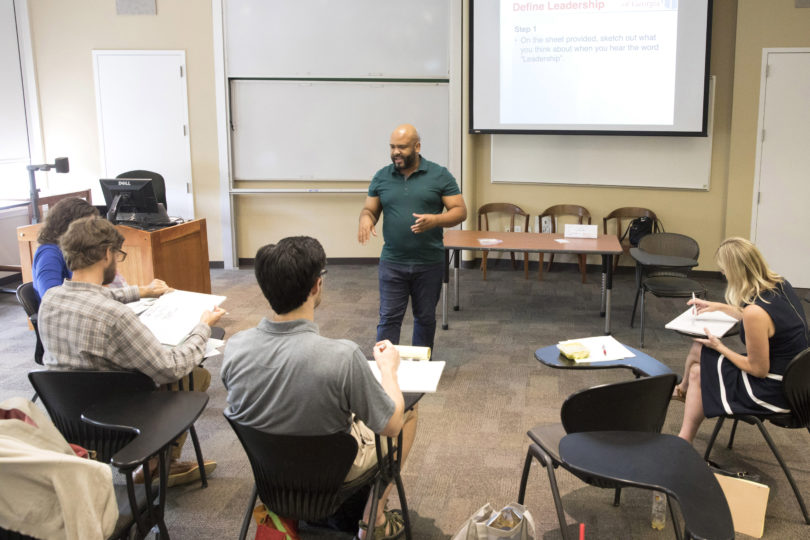Active learning is much more than group projects.
For the participants in the Center for Teaching and Learning’s Active Learning Summer Institute, it’s a shift in mindset to making sure their students are purposefully engaged in the material.
“We are experts in the content, but we can always be developed more in the strategies and procedures that we use to work with our students,” said James C. Anderson II, assistant professor in agricultural leadership, education and communication in the College of Agricultural and Environmental Sciences.
Anderson was one of 24 participants in this year’s Active Learning Summer Institute, hosted by CTL. Twelve faculty members participated in two cohorts—the first group met May 13 through June 7, and the second met June 10-28. They will continue to work with their assigned consultant from CTL throughout the academic year and have access to programming such as lunch and learns, workshops and seminars specially designed to support this group.
The cohorts, who were selected through a nomination and application process, met daily for group feedback sessions on course materials and discussion of active learning pedagogy and other evidence-based teaching practices with the goal of redesigning one of their courses to incorporate more of these strategies.
“All of those opportunities to actually sit down and open up your course to others to get feedback were so valuable to me,” Anderson said.
The institute began in 2018 as an effort to promote a wider adoption of active learning pedagogies. UGA President Jere W. Morehead designated $250,000 for an intensive program to help faculty incorporate active learning strategies into their undergraduate courses. A total of 55 faculty have participated, and up to 24,000 students will have been taught in their redesigned classes by the end of the 2019-2020 academic year.
“The first thing I want the faculty participants to think about is what active learning means to them in their context and for their students,” said Megan Mittelstadt, director of the Center for Teaching and Learning. “I want them to be able to articulate not only what active learning is, but also what it is in their discipline and for their students.”
According to Mittelstadt, there are a variety of active learning techniques that all enhance learning outcomes for students.
“Students in active learning classes regularly practice working with new ideas and reflect on or receive feedback on their work, a cycle that fosters deeper understanding,” she said. “We know that knowledge that is acquired with context and relevance is more durable. So, students who practice applying knowledge not only perform better in that semester, but they also are more likely to retain that information for longer.”
One of the techniques that stood out to Anderson was the Transparency in Learning and Teaching (TILT) strategy, where the instructor clearly explains to students why they are doing a particular assignment or project. By giving students context and helping them understand the value of the assignments and projects, they become more invested in the learning process, leading to better learning outcomes.
Anderson, who redesigned his leadership and service course (ALDR 3900S), plans to incorporate TILT into his course so that expectations are set and students understand the purpose of the assignments. He said he hopes it encourages students to find meaning in what they are doing.
Michelle Lofton, who teaches in the School of Public and International Affairs’ public administration and policy department, wants the students in her public financial administration course (PADP6930) to come away with critical thinking skills and the ability to ask the right questions.
“Active learning techniques are a great vehicle to learn those higher-order skills,” she said.
Lofton, assistant professor of public administration and policy, will be teaching in an active learning classroom, but she also wants her students to co-generate some of the content. For example, she plans to have her students develop a budget, including expenditures and revenues, for a public agency. Not only does this create discussion points, but it also allows students to build on prior knowledge and skills to successfully achieve core competencies.
Hillary Tanner’s engineering graphics and design course (ENG1120) already includes active learning techniques by virtue of the content, but her goal is to “add the why.”
To do that, she plans to include a quiz wrapper—a set of questions that allows students to reflect on what did and didn’t go well on the quiz. This gives students the opportunity to make adjustments to better their grades on future assignments and Tanner the opportunity to see if there is content that needs to be revisited.
“The format of my class is already very active, but this has helped make it more intentional,” said Tanner, a senior lecturer in the College of Engineering.
Hua Chen, an assistant professor in Terry College of Business’ department of marketing, plans to include more check-ins with students in his marketing research class (MRK4000). That might include a few questions before class or reflective writing at the end of class to check understanding of the material.
In addition, Chen plans to include additional checkpoints with his students while they work on their research project to help them understand the importance and value of marketing research.
“We should make students the center of the learning objectives and learn more about where they really are,” he said.








